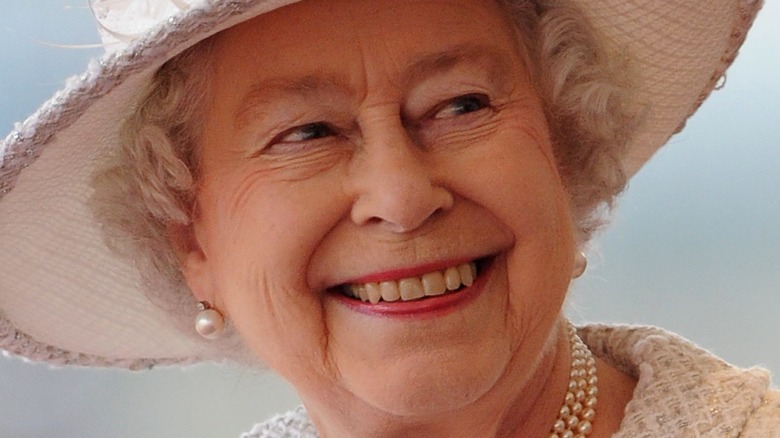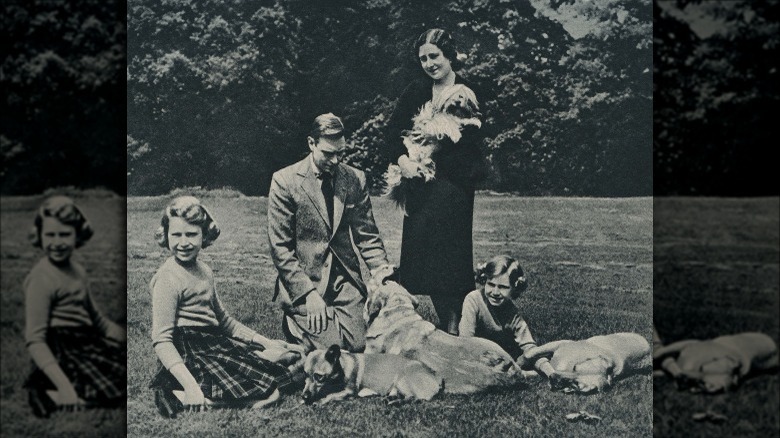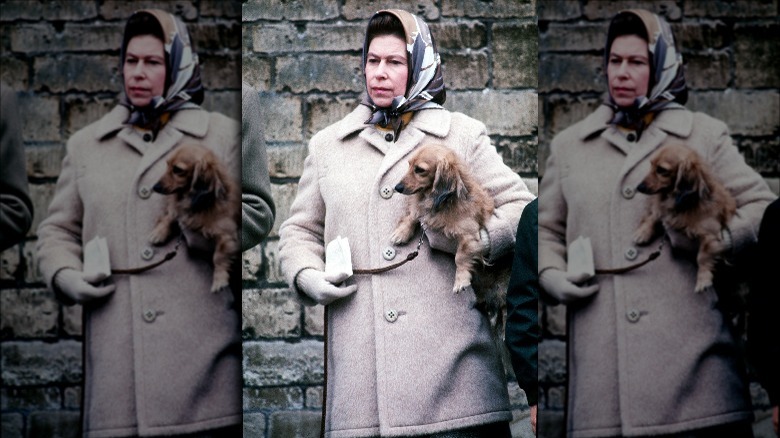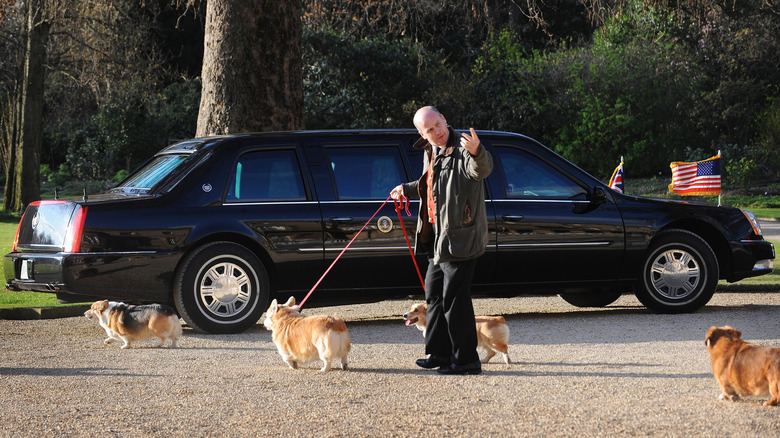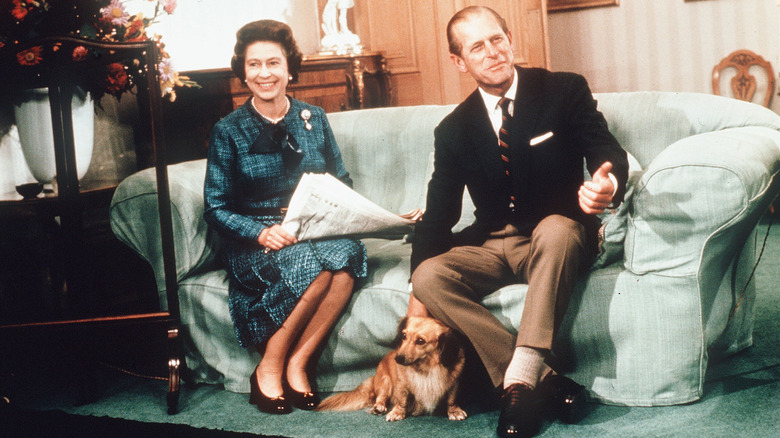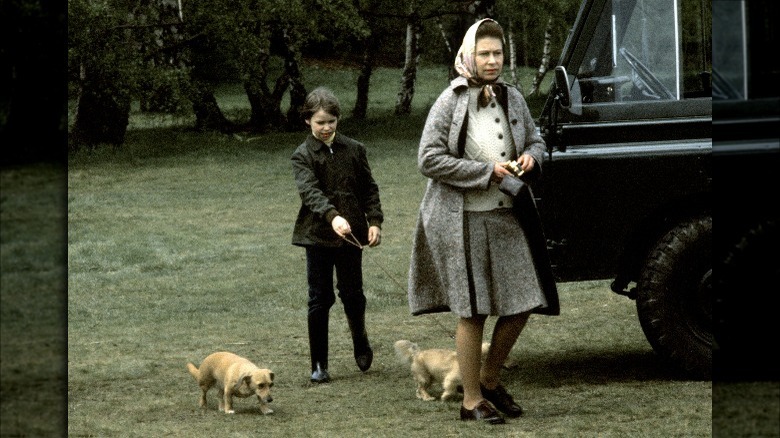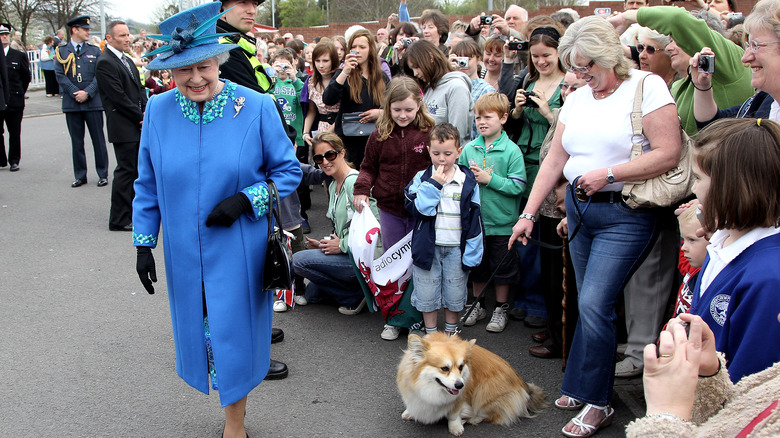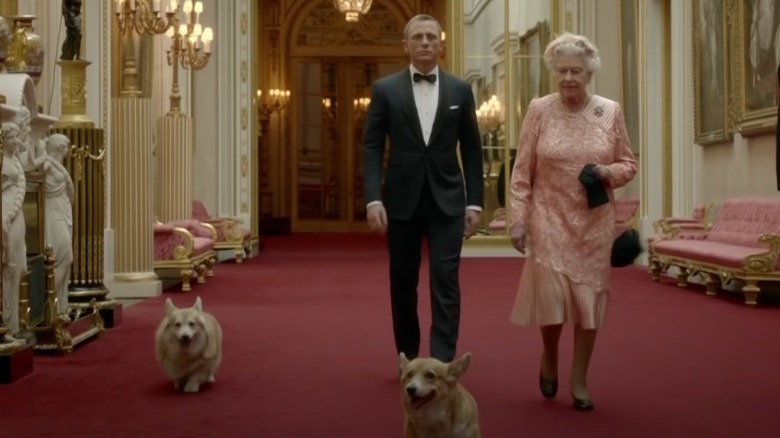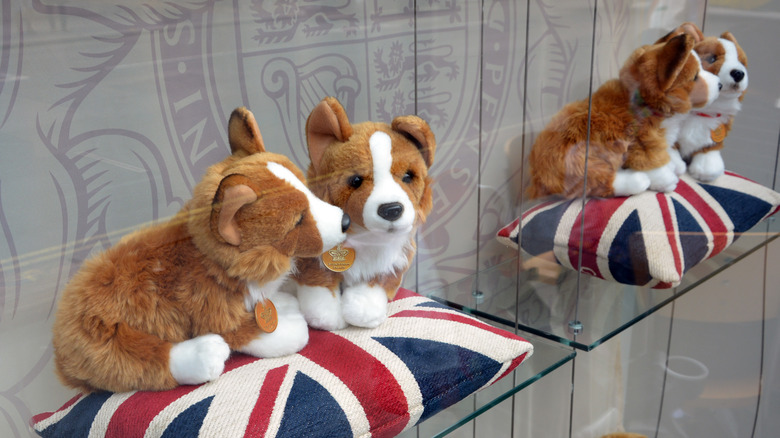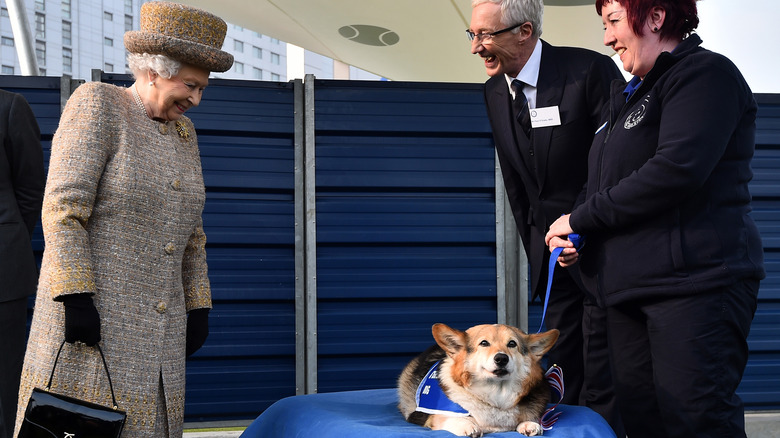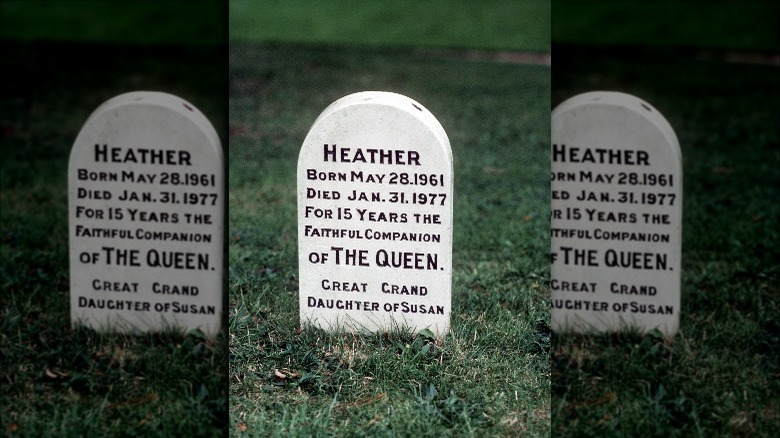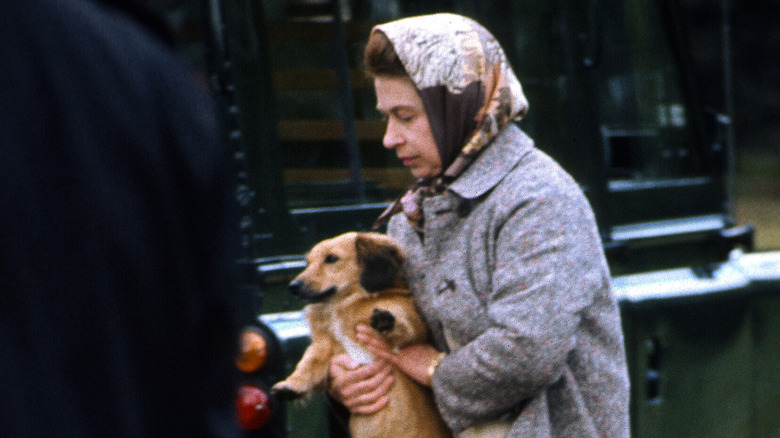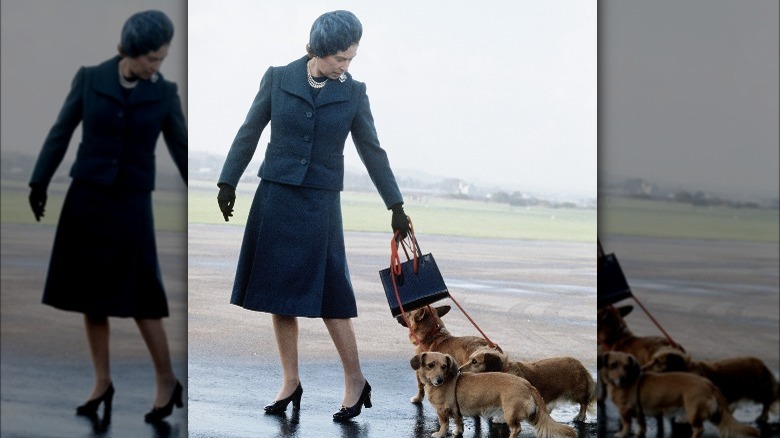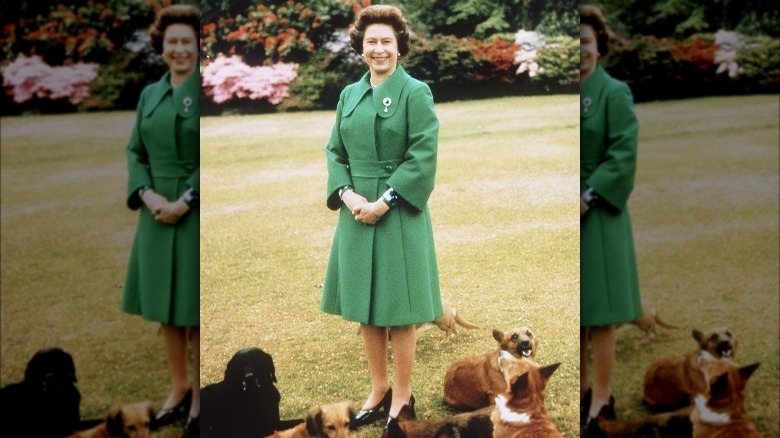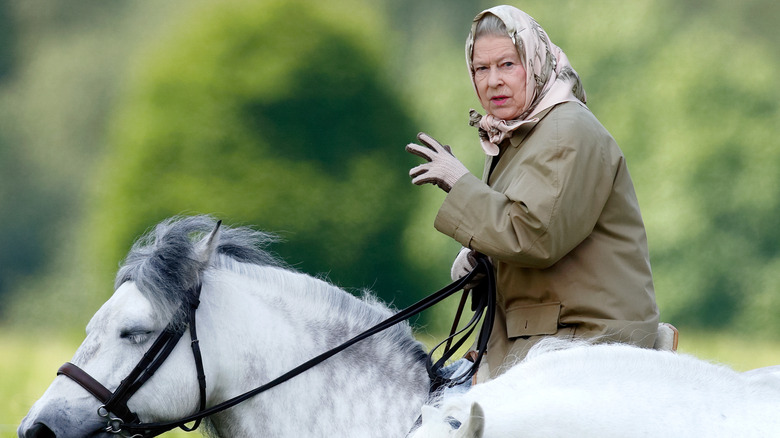The Untold Truth Of All Of Queen Elizabeth's Pets
We may receive a commission on purchases made from links.
While Queen Elizabeth II knows how to rock a colorful hat and has set the record for the longest-reigning monarch in British history, she might be equally well known for her deep love for animals. Her majesty's fervor is especially focused on two animal groups: horses and dogs ... and she's no half-way animal lover either. The queen is involved in the breeding, raising, and even grieving of her beloved canine and equestrian friends. When it comes to horses, Elizabeth rides, too. Her first riding lesson took place when she was just three years old, per the Independent, and has continued throughout her life. Even at age 94 in 2020, the queen was spotted near Windsor Castle taking a turn around the grounds on a fell pony, according to CNN. Basically? Horses are an ever-present fixture in this royal's life.
But when it comes to pets in the traditional sense, the kind that run around the house and curl up next to you in bed, nothing is more ironically linked to her majesty than the corgi. Her father, King George VI, is responsible for the breed loyalty, bringing home the family's first corgi in 1933, Hello! notes, when the future queen was just seven. The little heartthrob's name was Dookie, and since his introduction into the royal family, it's been corgis all the way.
This is the untold truth of all of Queen Elizabeth's pets.
Meet Queen Elizabeth's very first pets
While King George VI brought home the first corgi, Dookie, when Queen Elizabeth was just a child, she didn't receive her own personal dog until she was 18. As a birthday present, the future queen was gifted with Susan, a female corgi who remained with her for 14 years. Sadly, Susan died in January 1959, according to Express, at the royal residence Sandringham House in Norfolk.
As any dog lover knows, it's tough to be separated from our pooches, and that sentiment of attachment is no different when you're a royal. The story is that the queen snuck Susan into her carriage on her wedding day in 1947, Express notes, hiding her "under a pile of blankets" as the soon-to-be-hitched royal journeyed to Westminster Abbey. If Susan came for this big moment, it perhaps makes sense that Elizabeth also insisted on having her beloved pet accompany her as she and husband Prince Philip honeymooned at Scotland's Balmoral Castle.
But Susan didn't just spark a chord with the queen. She also instigated the monarch's interest in breeding. For years to follow, there were corgis who came from Susan's lineage and, as Town & Country notes, the last of Susan's descendants, Willow, died in 2018. So, Susan's impact was significant, sparking a royal corgi bloodline.
All about the queen's corgis
One of the perks of being the monarch is that Queen Elizabeth doesn't have to walk her corgis first thing in the morning. There's a footman for that! However, for walks later in the day, the queen opts to get involved, taking them out for a stroll throughout Buckingham Palace's greenery following the loyal little royal pets' lunch, Hello! notes.
The appearance of the queen with her pack of corgis was such a vision that even Princess Diana commented on it. "The Queen is always surrounded by corgis so you get the feeling you are standing on a moving carpet," she once said to James Hewitt, according to USA Today. In fact, when the queen was briefly hospitalized in October 2021, she was later given strict instructions by her doctors to rest — and this included no corgi walks. It was reportedly a huge blow to Elizabeth, who considers the activity her "tonic," per the Daily Mail. Thankfully, the queen was limited from her daily delight only for a week.
Penny Junor, a royal biographer, stressed how essential this routine is for the monarch. "Her corgis are hugely important to her," Junor said (via The U.S. Sun). "They have over the years been closer to her than any human being." Queen Elizabeth even makes Christmas stockings for her pooches, per Hello!, stuffing them with treats and presents. Clearly, these little corgis are everything to the long-reigning monarch.
There's literally a corgi room at Buckingham Palace
Quite possibly the cutest room imaginable at Buckingham Palace is the corgi room. Chef Darren McGrady, who was a personal chef to the royal family for over 15 years, explained in a 2020 YouTube video what the ins and outs of corgi life was like at the palace. "They sleep in little wicker baskets in the corgi room and [are] looked after by two footmen," he said. "Doggie 1 and Doggie 2, that's what we used to call them." The bedding in the wicker baskets get "changed daily," according to The Sun.
Meanwhile, any porcelain dishes from the kitchen that got nicked or scuffed over the years got reappropriated into a dog dish. While Chef McGrady worked his way up to cooking for the queen, Prince Philip, and even Princess Diana, he explained that one of his first jobs at the palace was cooking for the corgis. "The dogs would have a whole selection of different meats, cabbage, and rice," McGrady said, adding that the meat "had to be cut into a fine dice." The "reason" for this finesse "was to be sure that there were no bones in the meat," which ranged from chicken and beef to rabbit and liver. The rice and cabbage were there to keep the meals from being too rich.
And who fed the corgis? Queen Elizabeth herself apparently takes on that task, feeding them in order of pack hierarchy by arranging them in a circle and dolling out the carefully prepared food, per The Sun.
How did Prince Philip feel about the corgis?
While Queen Elizabeth is enamored by her corgis, the rest of the household wasn't always taken with them. In fact, the late Prince Philip allegedly "loathed" them, royal biographer Brian Hoey wrote in "Not in Front of the Corgis" (via GoodToKnow), because he found them "too yappy." The duke wasn't alone in his dislike of the dogs, however, as both Princes William and Harry reportedly have complained of the same thing, according to Chef Darren McGrady — so clearly, the adorable pups can be a noisy bunch.
Palace staff have also apparently found them difficult. In Hoey's book, he explained that the dogs weren't always perfectly housebroken, but the staff couldn't interfere in any way besides cleaning up after them. "Nobody is allowed to raise a finger or a voice to any of the dogs," Hoey wrote, per Hello!. "They cock their legs and do what Corgis do wherever they want — on antique furniture, priceless carpets." When the dogs would relieve themselves on the flowerbeds, gardeners were likewise not allowed to interfere.
Did any of this stop the queen from continuing to fill the palace with dogs? Nope. Nor did it stop her from breeding them. Paul Burrell, who served as a footman to Queen Elizabeth and later as Princess Diana's butler, shared in an Instagram video that the facetious palace mantra was: "'Horses, dogs, husband, and kids.' And that was the pecking order." Well, at least everyone knows their place!
Queen Elizabeth is responsible for the dorgi
Queen Elizabeth, among many other credits, actually invented the dorgi breed, the combo of corgi and dachshund. The genesis of the breed happened quite by accident. The queen's sister, Princess Margaret, had a dachshund named Pipkin who had an unplanned opportunity to get close to one of the queen's corgis, named Tiny, according to People, and along came a litter of puppies.
The serendipitous breeding was such a hit that the family kept up the tradition with several dorgis following, boasting sassy little names like "Cider, Rum, Berry, Candy, Brandy, Chipper, Harris, Pickles, Piper, Tinker, and Vulcan," per the outlet. No wonder they continued the lineage; the dorgi has the long body typical of both breeds, with short legs, but can bring the charm of long hair, typical to dachshunds and less common to corgis.
The end of the line, which stopped with Vulcan, happened in 2020, according to a later publication by People. The sad news came only weeks after Prince William and Kate Middleton lost their dog, Lupo, a cocker spaniel. On the Duke and Duchess of Cambridge's Instagram account, they wrote: "Very sadly last weekend our dear dog, Lupo, passed away. He has been at the heart of our family for the past nine years and we will miss him so much. – W & C." The deaths were not related in any way, just really bad timing for a family of dog lovers.
She got two new dogs ahead of her 95th birthday
There was much fanfare over the fact that the corgi population was dwindling at Buckingham Palace in 2018. Queen Elizabeth previously expressed her desire to stop breeding so as not to "leave any young dog behind," equestrian advisor Monty Roberts told Vanity Fair. She was also apparently worried about the potential "tripp[ing] hazard" of energetic dogs getting underfoot, per The Sun. "Her main fear is that if she fell and broke her arm or even a leg she would not be able to perform her duties for many weeks if not months," a palace courtier told Express. "And that would upset her greatly."
Just as everyone was trying to wrap their heads around the idea of the queen without corgis, Prince Andrew gifted his mother with two pups two months ahead of her 95th birthday, a corgi named Muick and a dorgi called Fergus, the latter of whom sadly died in May 2021, per the Mirror. Notably, they were the first to not come from her first dog, Susan's, lineage. But according to a source, they were a "great comfort" to the long-reigning monarch, as they arrived when the queen was reportedly reeling from late Prince Philip's hospitalization that February, as well as Prince Harry and Meghan Markle's highly publicized interview with Oprah Winfrey that March.
As royal biographer Penny Junor facetiously said to The Sun, "The corgis are intensely loyal and loving and they have never let her down. And of course corgis also seldom rush off to LA to give interviews." Dang!
The queen and her celebrity pooches
Queen Elizabeth's corgis have taken on a life of their own. They're so synonymous with her reign that gift shops around Buckingham Palace are even packed with corgi-themed souvenirs. Royal biographer Brian Hoey even wrote the book, "Not in Front of the Corgis: Secrets of Life Behind the Royal Curtains," using the dogs as a way to pry open the life behind the royal family. Clearly, these pets are a central symbol of the queen's iconic life.
Perhaps the cutest moment of fame for all of the queen's corgis came in 2012, when London hosted the Summer Olympics. Audiences will remember the charming clip for the opening ceremony, featuring Daniel Craig playing James Bond as he walked beside the queen to receive his mission. Fun fact: Elizabeth only agreed to be in the video if she could speak. "Of course I must say something. After all, he is coming to rescue me," she reportedly said, according to Angela Kelly's book, "The Other Side of the Coin: The Queen, the Dresser and the Wardrobe" (via the Independent), choosing the line, "Good evening, Mr. Bond."
You don't get the queen without her corgis, and one pooch in particular, Monty, stole the show in the clip, which featured a few of Elizabeth's corgis running alongside herself and Craig in a palace hallway. They also rolled a few times for the camera, the cheeky little attention seekers, and stayed by the queen's side throughout. Clearly no one, not even James Bond, gets close to Queen Elizabeth without her corgis' consent!
Queen Elizabeth is responsible for the corgi craze
There might be the Kate Middleton effect or the Meghan Markle effect when it comes to clothing influence, but in the realm of canine inspiration, Queen Elizabeth has an effect all her own: corgi fever. The global obsession with the breed had its ebbs and flows, though. The continued appearance of corgis in photos of the royal family helped make the breed a favorite in England around 1951, and when she was crowned in 1952, Queen Elizabeth and her pack brought an even greater surge of interest, according to Vanity Fair, with corgi sightings all over the country, as families scooped up puppies from breeders.
Like all things, however, there was a dip in corgi fascination around the early 2000s. In fact, corgi interest dropped so low that the breed was "at risk of disappearing from" the world of dog owners. A dog breeder explained the dip to Vanity Fair, saying that they were "seen as an old person's dog."
But people eventually came back to their senses, and in 2019, the New York Post dubbed the corgi the "hottest dog" of the year. The increase came partially from public awareness that the breed was dying out, but also because Netflix's "The Crown" brought a renewed interest into the life of the royal family and, obviously, the family's favorite breed. A dog lover explained to the Post why he became interested in corgis: "They're loyal, fierce, strong and sturdy, and they aren't afraid of anything." We believe the queen would agree.
Her majesty's involvement in breeding
Queen Elizabeth isn't just a dog owner: She's a breeder, and a devoted one at that, with her interest in creating a corgi lineage beginning with Susan. Of course, the dorgi was then added to the list of her breeding accomplishments. According to the American Kennel Club, any puppies "from her kennel are registered under the affix of Windsor," and this prestigious label has attracted the collaboration from other renowned breeders. While a Windsor corgi from the queen could fetch a high price, she "never" sells her puppies, Vanity Fair notes. Instead, she'll give them away as gifts.
One of the unsung heroes of Elizabeth's breeding efforts was through a woman named Nancy Fenwick. Her husband, Bill Fenwick, was the head gamekeeper at Windsor Castle, and through this connection, Nancy and the queen became close collaborators, with the former taking on the role of primary corgi caretaker next to her majesty, according to AKC.
There's an expectation that the monarch doesn't go to the funeral of palace staff, but when Nancy died in 2015, Queen Elizabeth flouted this rule and attended, according to Express. Years later, when Bill was ill, the queen helped to care for his dogs, walking them for him when he was too sick to do it himself. An insider told the outlet, "The Queen was very fond of Nancy and Bill and they became close friends." Clearly, the way to the queen's heart is through her beloved pets.
There's a royal pet cemetery
American writer Agnes Sligh Turnbill once said, "Dogs' lives are too short. Their only fault, really." Everyone who has loved a dog knows that this is true, Queen Elizabeth included. Throughout her life, she's owned over an estimated 30 pups, and this means burying and grieving them, too.
Dookie, the first corgi her father brought home, died as World War II was breaking out, according to the American Kennel Club. Elizabeth had another corgi named Jane, who died in 1944, when she was killed by a passing car. Still a princess at the time, she took it upon herself to write the driver, absolving him of any fault. In Susanne Saben's book, "Pembroke Welsh Corgi and Corgis," she writes that "the average lifespan of the breed is 12 to 14 years." Then, of course, there are accidents and unexpected health concerns in some dogs. So, for Queen Elizabeth, saying goodbye to her loyal pets is a painful part of the cycle of dog ownership.
At the royal residence Sandringham House, there's a pet graveyard that has been in use since 1887, according to Hello!, when Queen Victoria buried a collie named Noble. Since then, Queen Elizabeth has used the designated area as the location for burying her dogs, with "commissioned gravestones" honoring her beloved pets. It isn't always easy, loving dogs so much.
Queen Elizabeth's corgis aren't always the sweetest
While Queen Elizabeth shows major breed loyalty, corgis aren't necessarily the gentlest dogs. They were originally bred to be cattle herders, so the little sausage-shaped tykes can be tough and bossy. This is effective when dealing with livestock, but in a domestic sphere, it can present a challenge. Buckingham Palace has a whole history of the corgis acting out. In fact, one of the Queen Mother's dogs, Ranger, was the ringleader in a 1989 incident which sadly ended in the death of a dog owned by Elizabeth, Vanity Fair reports.
Meanwhile, 1991 saw another violent misunderstanding between eight corgis. And clearly, it was a major showdown, as both Queen Elizabeth and her mother's chauffeur required medical attention — respectively three stitches and a tetanus shot — after attempting to step in, per The Sun. There are myriad reports of palace staff, as well as others, such as a postal worker and police officer, being bitten and nipped, an unfortunate if somewhat common trait among the breed. In fact, there are rumors, per Vanity Fair, that Susan, the queen's beloved first corgi, once bit the palace's clock winder, according to Maclean's.
Between this history and their barking, corgis can bring a somewhat ominous welcome to a meeting with the queen. But their nature as "heelers" has never deterred her renowned devotion to the dogs, nor did it ever stop her from bringing more into the palace.
The queen's pets have offered comfort during her reign
There's something about corgis that seem to offer Queen Elizabeth comfort and an escape from the pressures of ruling the UK. She unabashedly loves them, even once saying (via Vanity Fair), "My corgis are family." But more than anything, the queen's corgis may also give her a semblance of normalcy through a release from a life full of rules, manners, protocol, and potentially ingratiating people.
Prominent breeder Ally Boughton, for example, told Vanity Fair about the time that she and the queen met a new litter of corgis together. "We sat on the floor and talked about corgis," Boughton said. "There's a litter of puppies crawling around on our hands and knees and we're sitting on the floor being tramped on and chewed and bitten. Puppies don't care who it is, me or the Queen of England. ... They can chew bits of anybody."
Meanwhile, anthropologist Kate Fox explained on the Netflix docuseries "Royal Pets" in 2013 (via The Sun) that "our pets are kind of like our alter egos." In speaking of the queen's life, in particular, Fox noted, "If you think about it, she has to be even more repressed and inhibited and reserved and dignified, than the rest of us put together, and very rarely gets any opportunity to express what she's really feeling. Her inner brat doesn't get let out very often, does it?" While the queen has to remain prim and proper, it stands to argue that the corgis let out a wild side for her.
How her love of animals has impacted royal rule
Queen Elizabeth's love of corgis doesn't just make her own life better — it has also apparently impacted her royal rule in a positive way. While the queen famously has to keep her opinion and personal emotions out of her job, her devotion to her dogs speaks volumes to the rest of the world. Through them, she shows loyalty, flexibility, a sense of humor, and frankly, love.
Monty Roberts, the famous equestrian advisor who has served Elizabeth closely for decades, spoke about why this has been such an important part of her leadership. "The dogs are so critical, and the horses, the cows, and the other animals, the wild deer and the stags of Scotland — they all play into it, because in my opinion the Queen created an avenue by which people could include animals as a part of our social structure," he said, per Vanity Fair.
It also humanizes her. Queen Elizabeth feeds them when she can, she walks them, she breaks up the occasional dog fight, and so on. While she might be a monarch, she's still just a woman who loves her pets. When Roberts was asked on his website how he has been influenced by the queen's love for horses, he answered, "We must remember that Queen Elizabeth is the most influential world leader in all of our history, both for animals and for humans. The Queen's love of horses has been ... a positive factor in equine welfare." The same could be said for canine welfare.
Inside Queen Elizabeth's love of horses
We can't talk about Queen Elizabeth's pets without mentioning her horses. While they aren't pets in the traditional sense, she obviously loves her equine companions, and any horse owner knows that there's a close bond between rider and horse.
Windsor Castle's horse manager Terry Pendry told the Independent about the queen's intense dedication to horses, saying that she has "an almost telepathic bond" with a few of her favorites. "Her knowledge and expertise is well-known," Pendry said. "She names all of her horses and ponies herself and can remember the parentage of every single one." He added, "Her Majesty has a fountain of knowledge in all things equine, you might say a living encyclopedia." Much like the corgis, Elizabeth's horses seemingly offer a wild, spirited escape from the protocols of royal life, with Pendry noting, "These incredibly highly charged creatures, full of blood and muscle, are developed from birth with kid gloves and the sophisticated jigsaw of trying to put all the pieces together is a constant challenge that continues to intrigue the Queen."
They also bring out her competitive side, too, through horse racing: per the Independent, her horse, Estimate, "made [her] the first monarch to win the Ascot Gold Cup." Her love of horses also allowed her to be included in the ceremonial aspects of monarchy. As the Evening Standard notes, in her younger days, Elizabeth would ride sidesaddle in the Trooping the Color — her horses may give her a chance to let out her wild side, but she is the Queen of England, after all.

